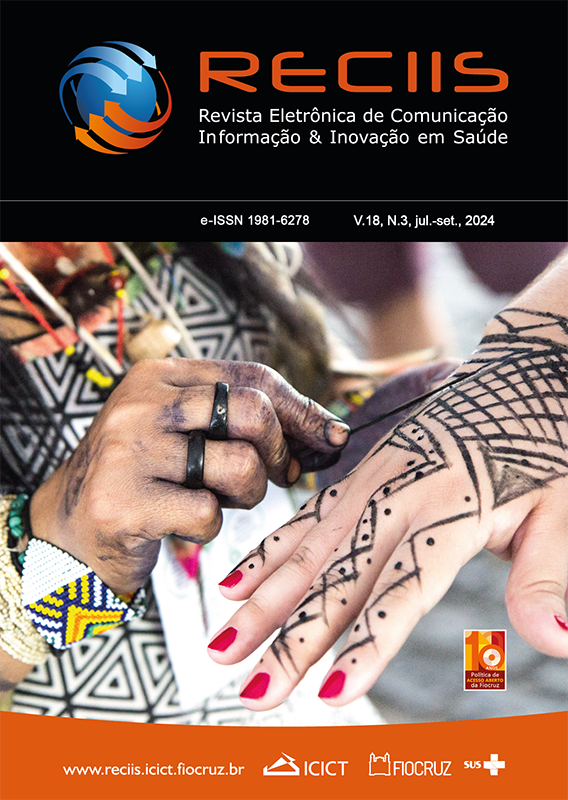Communicating the incommunicable? Women with endometriosis, asymmetries and limits of empathy
DOI:
https://doi.org/10.29397/reciis.v18i3.4208Keywords:
Pain, Communication, Empathy, Gender, EndometriosisAbstract
In this essay, we analyze the documentary Endometriosis: a life shaped by pain, a material that aims to “show, remove from invisibility and give voice” to women who live with intense chronic pain caused by endometriosis. We will preliminarily discuss the difficulties and potentialities of witnessing physical pain, based on the work of Scarry, Sontag and Bourke. Next, we will address three socio-historical factors that can help explain the silencing of patients’ experiences: first, the limits of medical compassion, especially related to issues of gender, class and race; second, the construction of the idea of the female body as inherently pathological; third, the complexities in the doctor-patient relationship as it intersects with gender. Finally, in the last topic of the work, we will examine the efforts of endometriosis patients to make their pain intelligible and modulate the response they want to receive from their interlocutors.
References
BERRIOS, German E. Classic text n 66: ‘Madness from the womb’. History of Psychiatry, Londres, v. 17, n. 2, p. 223-235, 2006. DOI: https://doi.org/10.1177/0957154x06065699. Disponível em: https://journals.sagepub.com/doi/10.1177/0957154X06065699. Acesso em: 6 ago. 2024.
BODDICE, Rob. Pain: a very short introduction. New York: Oxford University Press, 2017.
BOURKE, Joanna. Pain, sympathy and the medical encounter between the mid eighteenth and the mid twentieth centuries. Historical Research, Oxford, v. 85, n. 229, p. 420-452, 2012. DOI: https://doi.org/10.1111%2Fj.1468-2281.2011.00593.x. Disponível em: https://academic.oup.com/histres/article/85/229/430/5603386. Acesso em: 6 ago. 2024.
BOURKE, Joanna. The story of pain: from prayer to painkillers. New York: Oxford University Press, 2014.
CORREA, Amandha S.; ROHDEN, Fabíola. Síndrome dos ovários policísticos: performances “desatualizada” e “atualizada” em grupos no Facebook. Revista do Edicc, Campinas, v. 8, p. 7-16, 2022. Disponível em: https://revistas.iel.unicamp.br/index.php/edicc/article/view/6605. Acesso em: 6 ago. 2024.
COUSER, G. Thomas. Autopathography: women, illness, and lifewriting. Auto/Biography Studies, [s. l.], v. 6, n. 1, p. 65-75, 1991. DOI: https://doi.org/10.1080/08989575.1991.10814989. Disponível em: https://www.tandfonline.com/doi/abs/10.1080/08989575.1991.10814989. Acesso em: 6 ago. 2024.
EHRENREICH, Barbara; ENGLISH, Deirdre. For her own good: two centuries of the experts’ advice to women. New York: Anchor Books, 2005.
ENDOMETRIOSE: uma vida moldada pela dor. Produção: Dandara Reynaldo, Isa Luchtenberg e Maria Helena Nogueira. [S. l.: s. n.], 2019. 1 vídeo (28 min). Publicado pelo canal TV Endometriose Mulher. Disponível em: https://www.youtube.com/watch?v=tS-wjfl2jiQ. Acesso em: 1 abr. 2021.
GILMAN, Charlotte Perkins. The yellow wall-paper, Herland, and selected writings. New York: Penguin Books, 2009.
HEMINGWAY, Ernest. Contos. Rio de Janeiro: Bertrand Brasil, 2014. v. 1.
HOFFMANN, Diane E.; TARZIAN, Anitta J. The girl who cried pain: a bias against women in the treatment of pain. Journal of Law, Medicine & Ethics, Cambridge, v. 29, p. 13-27, 2001. DOI: https://doi.org/10.1111/j.1748-720x.2001.tb00037.x. Disponível em: https://www.cambridge.org/core/journals/journal-of-law-medicine-and-ethics/article/abs/girl-who-cried-pain-a-bias-against-women-in-the-treatment-of-pain/024AC6795D2AC4730D845F12790909CE. Acesso em: 6 ago. 2024.
HUME, David. Tratado da natureza humana. São Paulo: Editora Unesp, 2000.
MANTEL, Hilary. Giving up the ghost: a memoir. New York: Harper Collins, 2004.
MARTINS, Ana Paula Vosne. Visões do feminino: a medicina da mulher nos séculos XIX e XX. Rio de Janeiro: Editora Fiocruz, 2004.
MCGREGOR, Alyson J. Sex matters: how male-centric medicine endangers women’s health and what we can do about it. New York: Hachette Go, 2020.
MEIGS, Joe Vincent. Endometriosis: its significance. Annals of Surgery, Boston, v. 114, n. 5, p. 866-874, 1941. DOI: https://doi.org/10.1097%2F00000658-194111000-00007. Disponível em: https://journals.lww.com/annalsofsurgery/citation/1941/11000/endometriosis_its_significance.7.aspx. Acesso em: 6 ago. 2024.
MOSCOSO, Javier. Pain: a cultural history. New York: Palgrave Macmillan, 2012.
NEZHAT, Camram; NEZHAT, Farr; NEZHAT, Ceana. Endometriosis: ancient disease, ancient treatments. Fertility and Sterility, Nova York, v. 98, n. 6S, p. 1-62, 2012. DOI: https://doi.org/10.1016/j.fertnstert.2012.08.001. Disponível em: https://www.sciencedirect.com/science/article/pii/S0015028212019553. Acesso em: 6 ago. 2024.
NORMAN, Abby. Ask me about my uterus: a quest to make doctors believe in women’s pain. New York: Nation Books, 2018.
RICH, Miriam. The curse of civilised woman: race, gender and the pain of childbirth in nineteenth-century american medicine. Gender & History, [s. l.], v. 28, n. 1, p. 57-76, 2016. DOI: https://doi.org/10.1111/1468-0424.12177. Disponível em: https://onlinelibrary.wiley.com/doi/full/10.1111/1468-0424.12177. Acesso em: 6 ago. 2024.
ROHDEN, Fabíola. Ginecologia, gênero e sexualidade na ciência do século XIX. Horizontes Antropológicos, Porto Alegre, v. 8, n.17, p. 101-125, 2002. DOI: https://doi.org/10.1590/S0104-71832002000100006. Disponível em: https://www.scielo.br/j/ha/a/XrT4FHsQ9PQm6yJpM3Dmxsc. Acesso em: 6 ago. 2024.
ROUSSEAU, George S. A strange pathology: hysteria in the early modern world, 1500-1800. In: GILMAN, Sander L. et al. Hysteria beyond Freud. Berkeley: University of California Press, 1993. p. 92-223.
SCARRY, Elaine. The body in pain: the making and unmaking of the world. Oxford: Oxford University Press, 1985.
SEEAR, Kate. The makings of a modern epidemic: endometriosis, gender and politics. Surrey: Ashgate Publishing Limited, 2014.
SONTAG, Susan. Doença como metáfora. Rio de Janeiro: Edições Graal, 1984.
SMITH, Adam. Teoria dos sentimentos morais. São Paulo: Martins Fontes, 2002.
WOOLF, Virginia. On being ill. New York: Paris Press, 2002.
Downloads
Published
How to Cite
Issue
Section
License
Copyright (c) 2024 João Freire Filho, Júlia dos Anjos

This work is licensed under a Creative Commons Attribution-NonCommercial 4.0 International License.
Author’s rights: The author retains unrestricted rights over his work.
Rights to reuse: Reciis adopts the Creative Commons License, CC BY-NC non-commercial attribution according to the Policy on Open Access to Knowledge by Oswaldo Cruz Foundation. With this license, access, download, copy, print, share, reuse, and distribution of articles is allowed, provided that it is for non-commercial use and with source citation, granting proper authorship credits and reference to Reciis. In such cases, no permission is required from the authors or editors.
Rights of authors’s deposit / self-archiving: The authors are encouraged to deposit the published version, along with the link of their article in Reciis, in institutional repositories.












